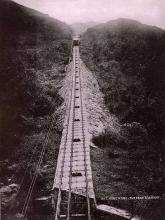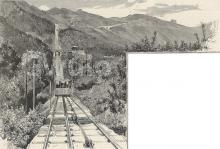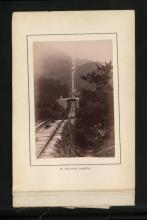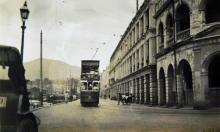Peak Tram [1888- ]
Primary tabs
http://books.google.com/books?id=pn8xAQAAMAAJ&dq=findlay%20smith%20peak%...
Industries and Iron, Volume 4 (Google eBook) 1888
When en route to Japan in 1876, I had the pleasure to meet, in Chicago, Mr. A. Findlay Smith, of Hong Kong, and during our journey between there and Yokohama he spoke of a tramway which he thought could be made to the Peak on the mountain behind the city of Victoria, and on meeting him again after the lapse of eleven years, I was both surprised and delighted to find his former crude ideas not only matured, but worked out; and I believe the Hong Kong High Level Tramway will be in operation before this is in print.
As probably few of your readers have been in Hong Kong, one of the most beautiful places in the Far East, it may not be out of place to state that owing to the hills rising abruptly behind the city, it has been hitherto cramped in its building extensions. The Government have made a series of splendid roads on the sides of the mountain leading to the Peak, and planted this once barren rock with many thousands of fir an other trees, under the superintendence of Mr. Ford, a gentleman highly skilled in arboriculture. This has enabled the wealthier residents to build houses on these terraces above the city, where they can enjoy the pure bracing air and lovely scenery. The completion of the high level tramway will not only enhance the value of the Government land, but render the whole mountain side available for building purposes, and make it a grand sanitarium within the reach of nearly all classes of the community.
The tramway has been laid own from St. John’s Place, Garden Road,to Victoria Gap, a length of 4690ft. The height of the upper above the lower terminus is 1207ft. The easiest gradient is 1 in 25, and the steepest I in 2. On the lower part of the line two steel rails of 35lb. per yard are laid, of 5ft. auge, and forming a single line; and on the upper half three rails are laid, forming a. double line. Half way is a cross siding with four rails about 130ft. long in the clear, having switches at the lower end. Steel sleepers, weighing 24lb. per yard, are bedded in lime concrete 6in. thick. The bridges, eleven in number, are constructed of wrought iron girders. The carriages are mounted on be 'es, and carry about orty passengers, and when loaded weigh between five and six tons. The motive power consists of two pairs of compound horizontal engines with multitubular boilers, each 40 n.h.p., and erected at the upper terminus. Motion is communicated to the carriages by means of a flexible (plough steel cable, 33in. in circumference, passing over groove winding drums, and tested to a. breaking strain of 54 tons.
At each end of the cable the carriages are attached, so that while one train ascends the corresponding train descends, passing each other half way. The cable will haul up at one time one hundred and twenty passengers, equal to a maximum working load of 7§ tons tensile strain. Cable guide pulleys are placed along the line at distances varying from three to eight yards. Each carriage is fitted with two steel clip brakes, arranged to grasp the centre brake rail, and to act at all times, unless held out of action by the brakesman; also with a pair of steel clip brake to work on the 35lb. rails. The centre brake rail is of steel, weighing 66lb. per yard, and is laid between the ordinary rails. It is jointed and fixed to the sleepers with steel bolts and clamps. Starting from the lower terminus, the line proceeds for about 400ft. in a south-west direction, when a slight curve, of 500ft. radius, alters the course to south-south-west, which is continued until an altitude of about 9()0ft. is reached, where a curve of 3001' t. radius changes the direction to west, after which it is almost straight to the upper terminus.
The speed will be about six miles per hour, and reduced to four miles at the points and crossings. There will be several stations, and a. single journey, wit out stoppages, will be made in ten minutes. The brakesman can at any time electrically signal the engine driver at the top to start or stop the train, and telephonic communication exists between the termini.
The inhabitants of Hong Kong are much indebted to Mr. A. F. Smith and his co-directors for e energy and perseverance with which this unique undertaking has been carried out, and I earnestly hope that it will more than realise the expectations of all concerned, both practically and financially. Mr. J. F. Boulton, Assoc.M.Inst.C.E., is the engineer in charge, and Mr. James Anderson the manager.





Comments
1946 Peak Tramways Report
China Mail 19 April 1946
The Peak Tram service was maintained until the morning of 17 December 1941, when a bomb fell alongside the track near the Points House, severed the rope in several places and brought down all overhead equipment. The following day, a bomb fell near the Engine House doing considerable damage. The upper terminus flats were hit many times by small calibre shells and on 24 December 1941 a large shell hit the building and exploded on the platform wrecking the car and doing extensive damage to the Engine House and one of the winding drums. The buildings were later repaired by the Japanese and the spare halves for brake side of drum which were in stock were fitted and the plant made serviceable again.
Of the two spare ropes in stock when hostilities commenced, one was used to replace the broken one and the other was removed later and after the surrender in August 1945 was found in a shipyard in Kowloon. Unfortunately, 1000 feet had been cut from it rendering it useless. The Japanese ran a service for approximately two years but this was eventually suspended in August 1944.
After the Japanese surrender, it was found that the workshop had been completely stripped of tools and machines but that the winding gear with minor repairs could be made serviceable and two ropes in good condition were woulnd up on the drums in the Engine House. It was necessary for the Company to order new equipment for the workshop and spare haulage equipment, In November 1945, a certain number of tools and equipment were supplied by the authorities and on Christmas Day 1945 the service was resumed.
China Mail 6 May1950
The cypress green coloured Peak Tram was put into service in May 1950. Transition between the "old and new " Peak Trams. Dated to approx. 1952.
Photos of the Peak Tram
Found this amazing compilation of many Peak Tram photos covering a wide span of time.
Peak Tram Authorisation 1888
Hongkong Government Gazette, No. 24. VICTORIA, SATURDAY, 26TH MAY 1888. VOL. XXXIV.
Notification by the Governor in Council under Section 25 of The Tramways Ordinance, 1883
Whereas the Surveyor General has certificated that the Tramway described as Tramway No. 6 in section 5 of The Tramways Ordinance, 1883, is fit for public traffic, it is hereby notified that the same is authorised, and the same is hereby authorised to be opened for such traffic.
ARATHOON SETH, clerk of councils
Council Chamber, Hongkong, 26th May. 1888.
Source here.
Peak Tram Regulations
982 THE HONGKONG GOVERNMENT GAZETTE, 21ST DECEMBER., 1889.
GOVERNMENT NOTIFICATION.—No. 522.
The following Regulations under The Tramways Ordinance, 1883, are published for general information.
By Command, A. LISTER,
Acting Colonial Secretary.
Colonial Secretary's Office, Hongkong, 21st December, 1889.
REGULATIONS
,Made the 16th day of December, 1889, by the Governor in
Council., under The Tramways Ordinance, 1883,
Section 42.
Application.
Number of passengers to be carried on tram car
Luggage, only to be carried on passenger car, under certain conditions
No stoppage for Passengers except at authorised Stations
Watchmen to be employed to prevent obstructions.
Time of Inspection and Testing of carriages &c., of Machinery &c.
Notice of alterations or changes in Machinery &c.
Velocity of carriages
Penalty for Breach of regulations
COUNCIL CHAMBER, HONGKONG. '
ARATHOON SETH,
Clerk of Councils
Source: HKGRO
Peak Tram Bridges
The history of Peak Tram Bridges can be found here.
Peak Tram MacDonnell Road Station
The Peak Tram stop at MacDonnell Road was introduced in mid-September 1936. China Mail 19 September 1936 refers.
Thank you moddsey for this
Thank you moddsey for this information. I created a place for the station.
Termination of Bowen Road Station
Mention is made on https://www.checkerboardhill.com/2019/06/hong-kongs-peak-tram-and-the-abandoned-station/ that the Bowen Road Station of the Peak Tram was closed on 1 January 1985 and merged with nearby Macdonnell Road Station.